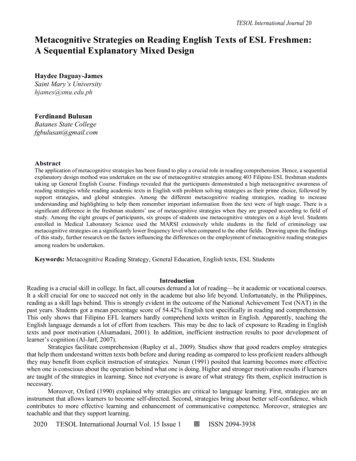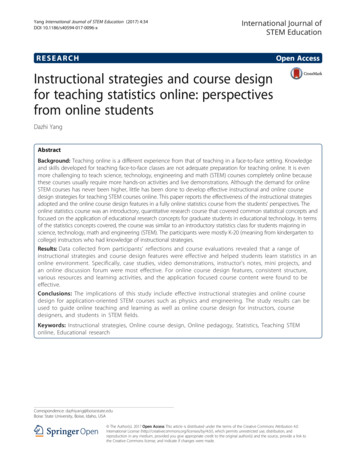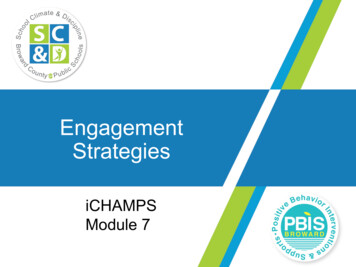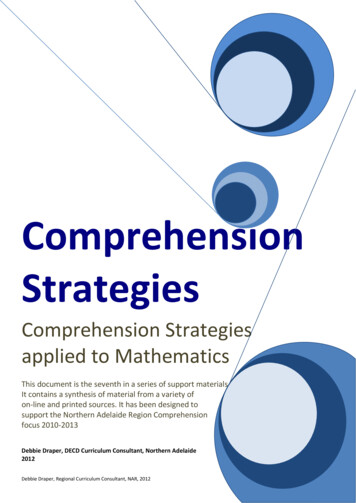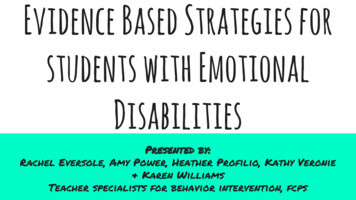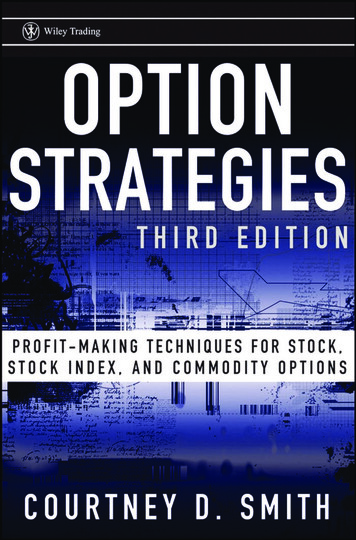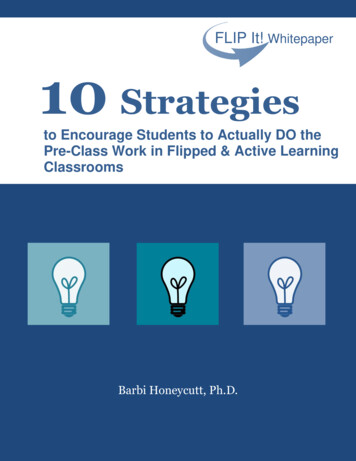
Transcription
FLIP It! Whitepaper10 Strategiesto Encourage Students to Actually DO thePre-Class Work in Flipped & Active LearningClassroomsBarbi Honeycutt, Ph.D.1
2016. Barbi Honeycutt. FLIP It Consulting, LLC. All rights reserved.Raleigh, North CarolinaNo part of this document may be copied, distributed, or posted in anydigital, audio, or hard copy format without prior written consent from the author.Unauthorized reproduction or distribution of any contents in this document will result incriminal and civil penalties and will be prosecuted to the maximum extent possible under law.In no event shall FLIP It Consulting, LLC, or any representative from FLIP It Consulting beliable for any damages whatsoever (including, without any limitation, damages for the loss ofbusiness profits, business interruption, loss of business information, or any other pecuniaryloss, including injuries to employees, participants, students, and/or third parties) arising outof or inability to use these strategies.Photo credits:PixabayFreedigitalphotosBarbi Honeycutt, Ph.D.FLIP It Consulting2
Table of ContentsIntroduction4Reflection Questions5The 10 Strategies6Strategy #1: Re-define the roles.6Strategy #2: Dig deeper.7Strategy #3: Address the fear.8Strategy #4: Clarify and make it visible.8Strategy #5: Create value.9Strategy #6: Give one free pass.10Strategy #7: Use focusing activities.10Strategy #8: Add timelines.11Strategy #9: Make connections.12Strategy #10: Assess early and often.13Conclusion13References and Resources14About the Author15Contact Information153
Introduction“How do you encourage students to actually DO the pre-classwork and come to class prepared ready to participate?”I have been traveling across the U.S. since 2011 leading workshops for educators from everytype of higher education institution. From small private liberal arts colleges to large researchuniversities, this is, by far, the most frequently asked question I hear from faculty who areteaching using flipped and active learning models.It’s not a new question, really. We’ve always struggled with how to encourage our students todo homework, read, and prepare for class. However, recent conversations about the flippedclassroom and inverted instruction have launched this question straight to the top of the listof challenges we all face when implementing these learning-centered models.In my work, the FLIP means to “Focus on your Learners by Involving them in the Process.”When you FLIP, you move the lower level learning outcomes outside of class and focus on theapplication and synthesis of higher level learning outcomes during class. But there are manyother interpretations of this approach. Blended learning, inverted instruction, flippedclassroom, flipped mastery, problem-based learning, inquiry-guided learning, case-basedlearning, team based learning, SCALE-UP.different names for the same philosophy. Andthey all share one similar challenge: They all depend on students coming to class preparedand ready to engage in application of content.If you teach courses based on any of these active learning models, you will face the challengeof how to address the issue of unprepared students. Unlike courses where content is primarilydelivered through lecturing during class time, courses based on active learning rely heavily onstudent involvement and application of content during class time. It’s nearly impossible forstudents to “get by” without doing the work to prepare for an active learning experience.You can have the most effective lesson plan, the most creative learning activity, and the mostinnovative technology to illustrate your points. But, if your students aren’t prepared,then it defeats the whole purpose of the learner-centered environment.4
Reflection QuestionsTake a moment to reflect before you review the strategies.Before you review the 10 strategies and decide which ones you want to implement, take amoment to consider these reflection questions. Your responses to these questions may helpyou choose which strategies work best for you and your students and decide what type oflearning environment you want to create. What are some of the fears my students face in my classroom? Are they intimidated bythe topic? What experiences are they bringing with them? Am I allowing space forthese feelings and experiences in the lessons I design? How can I be proactive rather than reactive when students aren’t prepared? How do Ireact when students aren’t prepared? What can I do to create learning environments where students feel motivated tocomplete the pre-class work? How can I support students through the transition from being a recipient of knowledgeversus becoming a learner who actively seeks to construct new knowledge? What can I do to design learning experiences where students see the value in doing thepre-class work? What challenges do I know my students face when completing their pre-class work andpreparing for the next lesson? Can I help reduce or eliminate some of these challenges? What are some strategies I already use to set students up for success in the activelearning environment? Which of these strategies work well? Which ones do I need tochange?5
Why is active learning important to me and my students? How do I communicate thisto my students and help them see the value of this type of learning experience?StrategiesStrategiesHere are 10 strategies you can use to encourage studentsto come to class prepared and ready to participate:Strategy #1: Re-define the roles.Just as you are learning to teach this way, your students are learning how tolearn this way. The idea of student-led instruction may be confusing and they may notunderstand their role and responsibility in this type of learning environment.Have a conversation early in the semester with your students to discuss the design of thecourse, their role in the space, and why this type of teaching and learning matters. Do anactivity on the first day of class to give students an idea of how class time looks and feels.Then, debrief the experience with them, answer questions, address concerns, and encouragethem to trust the process.I actually use my syllabus as the active learning experience on the first day of class. I embed“big questions” in the same font as the rest of the syllabus so students have to read it as theyhunt for the next question. The questions might relate to the course material, students’ fearsor concerns, and/or what areas of the course students are looking forward to the most. Formore about this strategy, see the Faculty Focus article, “A Syllabus Tip: Embed BigQuestions.”Based on your answers to the reflection questions on page 5, you may need to make thisconversation more formal with your students. You may decide to draft a “contract” oragreement specifically outlining their responsibilities and defining the partnership betweenyou and your students. This could be an extension of your syllabus or a completely separatedocument.6
If this type of formality makes you uncomfortable, but you still need to provide students withmore structure, try to co-create a document or agreement with your students so they have avoice in outlining expectations and clarifying their role.Strategy #2: Dig deeper.When students arrive to class unprepared, it can be easy to assume they are lazy, apathetic, oruninterested in the course. While that may be true in some cases, many of the collegestudents I meet are smart, hardworking, and motivated to succeed. Surely something elsemust be happening if they are continuing to come to class unprepared.One possible answer can be found in the work of Drs. Richard Felder and Rebecca Brent. Intheir work on active learning, they found, “Students forced to take majorresponsibility for their own learning go through some or all of the stepspsychologists associate with trauma and grief: Shock, Denial, Strong emotion,Resistance and withdrawal, Struggle and exploration, Return of confidence, andIntegration and success” (Felder & Brent, 1996, p. 43.)I wrote about this phenomenon in a blog post about how to address student resistance in theflipped classroom. The range of emotions may explain why some students resist active andstudent-centered learning approaches. Resistance may show up as anger (“I pay you to teachme!”) or isolation (“I’d rather just do this assignment on my own instead of with a group”).I recently spoke with groups of faculty from several large research universities across thecountry who were involved in re-building new classroom spaces to fit with the SCALE-UPmodel. In this model, the physical classroom space is designed to accommodate activelearning, technology integration, and group work. Instead of desks, there are roundtables.Each table has laptops. Multiple screens are positioned around the room on each wall. Assoon as students walk into the room, they know they’re in a different type of classroom. WhenI spoke to faculty teaching in these spaces, several of them said some students walk in on thefirst day and turn around and walk right back out the door. They didn’t even give it a chance.Reactions like these may be coming from somewhere else besides laziness or lack of interest.Dig a little deeper. Do you see where your students might be on the steps associated withgrieving? Did they have a negative experience in previous flipped classroom and they are nowbringing those negative feelings into your class? Are their behaviors coming from a place offear (see Strategy 3)?7
Strategy #3: Address the fear.One thing will destroy active student participation in the classroom: fear. If students areafraid, they may come to class prepared, but they fear actually participating in class activities.Maybe they are afraid of being called on and giving the wrong answer. Maybe they are afraidthey will be ridiculed or attacked by their peers for sharing their opinion. Maybe they areafraid of speaking in front of a large group. Maybe they are afraid of or intimidated by thecourse material and how well they’ll do in the class.To help address the fear, share stories of successful leaders, scholars, athletes, scientists,actors, musicians, entrepreneurs, and other influential people who have healthy perspectivesabout fear. Bring in inspirational quotes, case studies, or statistics to show students how toovercome this fear, or at least channel it into positive action. Share data about trends inprevious active learning classes and highlight how students’ grade or performance improvedover time.For some students, being actively engaged in a classroom is risky and scary. Tryto address these fears and create a learning environment that is “safe” forsharing ideas, collaborating with others, and taking risks. Help students becomecomfortable with ambiguity. They don’t have to know all of the right answers all of the time,and that’s okay. Learning is messy, dynamic, and requires active involvement. The flippedclassroom magnifies all of these characteristics. And that’s why it can be such a scary place forsome students.Strategy #4: Clarify and make it visible.We cannot measure what we cannot see, touch, taste, feel, or hear. How do you know ifstudents actually did the pre-class work if you don’t have a way to measure it? How dostudents know if they finished the pre-class work correctly if they don’t have a way to measureit themselves? How are you going to hold students accountable for doing (or not doing) thepre-class work if students can’t show it to you?Sometimes your instructions about a pre-class assignment may be clear to you, but not toyour students. Thanks to the Curse of Knowledge, when we know something, it’s hard toremember what it’s like NOT to know it anymore. This “curse” interferes with our ability tocommunicate clearly because we can’t put ourselves back into the position of our studentswho don’t have the same level of knowledge we do. It may be clear to you, the expertwith knowledge, but not to a novice without the same level of knowledge andexperience.8
To overcome this challenge, pay attention to both the learning outcomes and the pre-classassignment. Are the learning outcomes specific and measurable? Can your students showthem to you? Can students complete them within the time frame given? How can you clarifythe task and the expectations? Do students need an example, an outline, or a template?Another way to think about this challenge is to ask yourself, “What is the result of the preclass work?”Let’s take, for example, a typical pre-class assignment, “Read Chapter 5 before class.” Howwill you know if students read it? Are you assigning a quiz or reflection activity? What shouldthey do when they read? Should they outline the chapter, draw a mind map of the concepts,or answer the questions at the end of the chapter? What should students be able to do oncethey finish reading chapter 5? What can they bring in as visible evidence they completed thepre-class work? What is the result of reading chapter 5?The answer to these questions should connect to the in-class activities you have planned. Thetime during class is when students will demonstrate that they have, indeed, completed thepre-class work and are prepared to participate.Sometimes students don’t know exactly what they are supposed to do in the pre-classassignment. The more you can clarify the task, specify the expectations, and make visiblewhat it is students need to be able to do with their pre-class work, the more likely yourstudents will actually do it because now it can be measured.Strategy #5: Create valueAs a follow up to strategy 4, when you design the pre-class assignment, make sure it will beused to support the in-class activities. When students see how their pre-class work isvalued and how it is used in class, they will be more likely to come to classprepared and ready to participate.To create value, make sure you design the in-class activities so the result of the pre-class workis put to use. You could ask students to take notes on the chapter which they can bring in anduse as “open notes” on a test or quiz during class.You could ask students to draw a mind map of one concept from the reading. When they getto class, they can work in their groups to integrate everyone’s individual maps to create onecohesive map of the chapter.9
You could ask students to choose a stance from a controversial case study and use class timeto present their side and support their stance with evidence they gathered from the readings.And students do value grades. You may need to formally grade pre-class work for students tosee the value beyond the in-class activities. You can collect pre-class work randomly and atunannounced times to keep students on task and to prevent grading from becoming toooverwhelming.There are many ways to create value from the pre-class work. The key is to connect it to thein-class activities so students see how their work will be used and why it matters.Strategy #6: Give one free pass.Life happens. Sometimes you just need someone to give you a break. Do this for students bygiving them one “free pass” on any pre-class assignment. Students will be relieved they have afree pass as an option, and they will respect you for respecting their situation. Whether it’sout of their control or a poor choice they made, give them the chance to skip thepre-class work one time without penalty.This strategy does require a little more recordkeeping on your part. During class, if you noticea student is unprepared, tell him or her “that’s your one free pass” and make note of it in yourgrade book or within your learning management system. You could also prepare actualprinted “free passes” of your own using laminated cards or some other physicalrepresentation of a “pass” or ticket to hand to a student who is unprepared.Make sure students know when they have used their free pass. And, make sure they knowyou’re keeping track of it. Sometimes if they know you’re paying attention and they’re not justanother face in the crowd, it’s enough to motivate them to do the work and come to classprepared.Strategy #7: Use focusing activities.A focusing activity is a way to focus students’ attention the minute they walk in (or log in) toclass. Focusing activities are designed to get students’ attention, prompt their thinking aboutthe course material, and encourage engagement immediately.When used in conjunction with flipped and active learning classroom models, focusingactivities allow you to minimize distractions, maintain momentum between pre-class and in10
class activities, and maximize the amount of class time you have to engage students inlearning. Focusing activities encourage students to come to class prepared andready to apply the information from their pre-class work.Focusing activities also help you establish “routines of engagement” in your class. By routines,I mean students will learn that each class opens with some type of activity where they willneed to be able to recall or use their pre-class work. Over time, they will learn what to expect,how to participate, and what they need to do to prepare for class each time.A focusing activity is often used in the first five minutes of class time. For example, you canpost a quote on the board and give students two minutes to reflect on it before they discuss itwith a peer. You can post a quiz question to assess students’ comprehension of the pre-classvideo. You could present a graph of data points and ask students to interpret it before youmove to the next part of the lesson. All of these are quick ways to focus students’ attention,and they can also be used as assessment techniques.If you’re looking for more ideas for focusing activities you can add to your class, grab a copy ofmy book FLIP the First 5 Minutes of Class: 50 Proven Strategies to Engage Your Students.Strategy #8: Add timelines.This is a simple, yet effective strategy to help students organize their time and make realisticplans for completing their pre-class work. It can be particularly helpful early in the semesteras your students are learning how the flipped classroom works. It can also be helpful forstudents who are new to the active learning approach as they try to figure out how to balancetheir time outside of class to prepare to participate in activities during class.In your pre-class instructions, provide a timeline for how much time the pre-class assignmentshould take. For example, suppose your assignment states that students will watch a video,answer five quiz questions, and submit their responses through the learning managementsystem. Break it down and tell them how much time (on average) they should expect to spendcompleting the tasks. You might explain the video is 15 minutes and that the quiz questionsshould take approximately 15 minutes.You could also provide a document with a timeline and specific time stamps from the videowhere the most important information is presented. This helps students focus on what’s mostimportant from the video so they don’t waste time with information that is not as importantfor the particular assignment. One tip: double or triple the amount of time it takes you tocomplete the assignment (There’s the Curse of Knowledge interfering again!).11
And if you think “everything is important!” in the videos and the readings, think again. No,everything is not important. There are specific topics, quotes, sections, or pieces of a readingor video that more important than others. Your students probably don’t have the knowledgeor experience to filter this information, so you need to do it for them early in the process.Giving students this type of structure and support will increase the likelihoodthat they will set aside a realistic amount of time and energy to complete the preclass work and come to class ready to be involved.Strategy #9: Make connections.Another reason some students may not do the pre-class work is because they feel isolated ordisconnected. They feel like they are on their own doing the pre-class work and they can’t findany help or support from the instructor or from their peers. Students may feel alone as theywork through the pre-class material, and they may lack confidence in their level ofunderstanding. They may not know where to turn for help if they get stuck, and then they justdecide not to do the assignment at all.To help combat this isolation, build in support. You may decide to offer live chat “office”hours in the evenings to answer questions or provide more information. You may want to setup online forums for both you and other students to provide support and answer questions.And, as a bonus, if you are providing chat sessions or office hours during particular times inthe day or evening, then this will encourage students to get the work done earlier and notprocrastinate if they want the additional help. They will not be able to get direct help from youif they wait to complete their pre-class assignment an hour before class begins.You can also set up support structures for students to connect to other students so they don’trely solely on you. Set up online study groups and provide private discussion forums forstudents in those groups to share information and support each other. Develop a “frequentlyasked questions” resource guide based on questions students have asked in previoussemesters. Assign advanced upper-level students or graduate students as peer mentors orteaching assistants to answer questions and provide additional information.All of these structures provide connections between you and the students and among thestudents themselves. By providing a supportive environment beyond the in-personclass time, you will increase students’ motivation to complete their pre-classwork, especially if they know they’re not the only one struggling with aparticular section of the material.12
Strategy #10: Assess early and often.Sometimes students overprepare, overanalyze, or just spend too much time focusing on thewrong things when they are completing their pre-class work. Then they get frustrated whenthey say they completed the pre-class work but realize they spent their time on the parts ofthe assignment that were not as important. This whole situation leads them to avoidcompleting the pre-class work because they view it as a waste of time since theymisunderstood the assignment or focused on the wrong information.To address this, build in low stakes assessments early in often. Assess the result of thepre-class work to identify where students are struggling, what topics are mostconfusing, and which types of resources you need to create or add to the courseto help students succeed. These assessments can also be used to improve clarity,directions, and expectations about pre-class work.Low stakes assessment techniques, or classroom assessment techniques (CATs), aren’tusually graded although you might want to include them in an overall class participationgrade. These types of assessments give students the chance to practice before they are testedmore formally on the concepts.For example, you can ask students to vote on how confident they are in their answers to thepre-class assignment. Or, give them writing prompt to respond to and post to a discussionboard so you can browse the posts for common themes and questions. You can design apractice quiz and give students time to work in groups to formulate their responses before youbegin a class discussion. There are hundreds of classroom assessment techniques you canintegrate into your course to assess students’ learning and confidence.Think about providing checklists, rubrics, and self-guided tutorials based on what you alreadyknow about where students struggle the most with the course material. These types ofassessments will give students the chance to identify gaps in their own knowledge so they cancome to class ready to ask questions or begin working on the next task.ConclusionI hope these strategies help you generate ideas to add to your classes to enhance studentmotivation and address the challenges of students who come to class unprepared. It’schallenging to stay committed to the goal of active learning when you face so many hurdlesalong the way. But, with these strategies and your energy and enthusiasm, I know you andyour students will be successful!13
References & ResourcesTo learn more about active learning and student resistance:Felder, R. & Brent, R. (1996). Navigating the bumpy road to student-centered instruction. CollegeTeaching, 44(2), p. 43-47, Taylor and Francis Group.Honeycutt, B. (2013). Five ways to address student resistance in the flipped classroom. FractusLearning. Online at: resistance-flippedclassroom/To learn more about engaging students with the syllabus:Honeycutt, B. (April 16, 2012). A syllabus tip: Embed big questions. Faculty Focus. Online at: -design/a-syllabus-tip-embed-big-questions/To learn more about The Curse of Knowledge:Heath, C. & Heath, D. (2007). Made to stick. Why some ideas thrive and others die. New York: NY.Random House.To learn more about classroom assessment techniques:Angelo, T. A. & Cross, K. P. (1993). Classroom assessment techniques: A handbook for collegeteachers. San Francisco, CA: Jossey-Bass.To learn more about active learning and flipped classroom models:Bergmann, J. & Sams, A. (2012). Flip Your Classroom: Reach Every Student in Every Class EveryDay. International Society for Technology in Education.Bonwell, C. and Eison, J. (1991). Active learning: Creating excitement in the classroom (No.1).Washington, DC: George Washington University Clearinghouse on Higher Education.Gerstein, J. (May 15, 2012). Flipped classroom: The full picture for higher education. Online r-educationFaculty Focus Newsletter: Higher Education Teaching Strategies from MAGNA Publicationshttp://www.facultyfocus.com14
About the AuthorDr. Barbi Honeycutt is a speaker, scholar, and author. Throughout thepast 16 years, she has facilitated more than 3,000 professionaldevelopment events for more than 15,000 faculty, graduate students, andpostdocs around the world.Dr. Honeycutt is the founder of FLIP It Consulting in Raleigh, NC, and anadjunct professor. The “FLIP” means to “Focus on your Learners byInvolving them in the Process.”Prior to launching her own educational consulting business, she was thedirector of graduate student teaching programs and the director of thecenter for teaching and learning. Dr. Honeycutt has published severalarticles and books based on her FLIP framework, teaching and learning inhigher education, faculty development, and graduate student professionaldevelopment.Contact Information: Let’s stay connected!Email:barbi@flipitconsulting.comFLIP It Consulting:http://www.flipitconsulting.comProducts & lting.com
Nov 10, 2016 · Take a moment to reflect before you review the strategies. Before you review the 10 strategies and decide which ones you want to implement, take a moment to consider these reflection questions. Your responses to these questions may help you choose which strategies work



